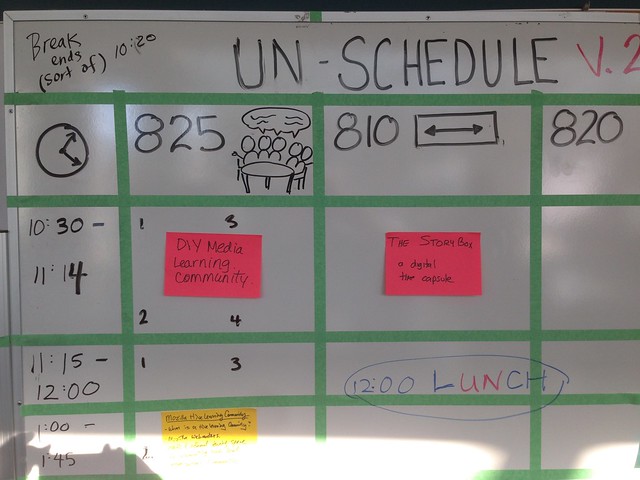Two weeks ago I was in Vancouver for the ETUG Fall 2014 Workshop, what a great gathering and with their un-conference format, a refreshing experience from the typical conference grueling treadmill present-o-rama format.

I was not sure I would stand up an pitch a session, but I was sort of prepared, I had brought the Storybox. It has been sitting idly since my return from New Zealand (a good sign was the battery still carried enough charge to last through my session).
There was not much trouble getting this group interested. I did less planning, and pretty much gave them the challenge to log on and figure it out.

I ended up collecting about 18 files, not bad for a quick session. The energy did fuel me, so I decided (although just acted on it 2 days ago) to clean out archive the content from New Zealand, and reset it for stops in Canada.
I’d like to see that sketch, Jason!
#etug participants having their way with @cogdog s Storybox. And I'm using the twitter tag feature why. pic.twitter.com/WKSQLSWVhK
— jason toal (@draggin) November 13, 2014
Still, I remain on the fence about keeping the stuff in the box (which is what makes it a time capsule) or to put it online so folks can access it. This time I flipped a coin and chose the latter.
Because I just love this media explorer I am using this time around; I made one especially for this current round. This is Infinite Grid Pro in action
What I like about this jQuery powered media display is that many media files can be explored; as you click and drag around, the media thumbnails fill in, so it does feel a bit infinite (and its randomized). Plus I have categories for different kinds of media- photos, audio, video, documents, and new this time around– Animated GIFs.
You may notice I have 62 pieces of media listed- that’s because I have to include at least 9 items for each categort, so I had to pad a few with older stuff.
I am overdue a writeup on all the changes I did for this version of the StoryBox. I completely replaced the entire stock interface of the PirateBox (you can learn how to set up your own at http://piratebox.cc/) using the Treble theme I have used on several sites (I wisely bought a multiple site license).
There’s a whole lot that went into this, moving the web content to the USB drive (so its easier to update), putting in place a small python wiki, and a crazy assemblage of shell scripts and local PHP code I set up to prepare all of the media. This even included digging into some PHP text functions to overlay file names on the thumbnail icons.
That’s a post for another day.

creative commons licensed ( BY-SA ) flickr photo shared by cogdogblog
It’s still just cool.

Have you looked at using a Raspberry Pi? I picked up the MR3040 AP, but didn’t like the limited ram, so I started playing with a Raspberry Pi (Model A) with a USB Ethernet adapter and the MR3040 for wireless. It will run for three hours off of the MR3040’s built in battery, which I can supplement with an external USB battery pack.
Not as compact as just using the access point, but more usable I think. I’m going to add node.js and see how well Etherpad will run on it. I’m afraid there may be a memory issue, but I could always go with a Model B and sacrifice battery life.
No Ryan. I’ve got little to no Pi experience- what are the extra capabilities you get? Curious if you could trigger other things, like when someone connects or uploads, a light signal or sound could go off?
What I have been wanting to try is to maybe set up a Pi as a media player, so it could receive the stream from the PirateBox built in UPnP media player and project out to a micro LCD projector.
The Pi basically runs Linux, but with 512MB of RAM in the B as compared to the 32MB in the TP link routers. The B+ should be better with battery. The Pi A gets about 30 minutes more off of the MR3040 battery, but it only has 256MB of RAM. Using the MR3040 as the access point not only provides battery backed up power, but it also can be charged at the same time, without power cycling the Pi.
With that much power, you can do things like install WordPress and have a mobile version of Truwriter. I’m looking at FluxxBB as a forum to try.
You should be able to monitor the log files and use Python with the GPIO pins to light up, make sounds, but I haven’t looked at that yet.
I’m documenting the set up, I’ll let you know when I put the notes online so you can check them out.
That is beyond cool, thanks for the details. I might have to get my Pi on in 2015.
So much fun! I’m glad we made that video–it looks good because the light was good. I’d forgotten about adding the music, but it isn’t awful. The site looks, as the kids say, really sick!